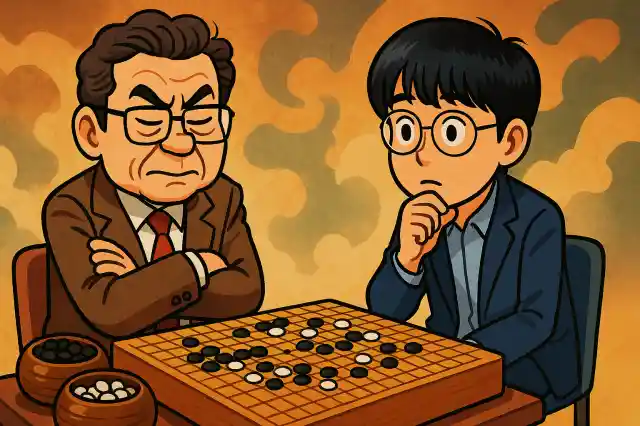Lost in Starlight: A New Korean Film Illuminating the Global Stage
The Rise of Korean Cinema and the Search for the Next Big Recommendation
Lost in Starlight is rapidly becoming a top recommendation for anyone seeking a fresh, emotionally resonant Korean film experience. The landscape of Korean cinema continues to evolve, captivating audiences worldwide with its blend of emotional storytelling, innovative visuals, and universal themes. As global interest in Korean films surges, English-speaking viewers are increasingly eager to discover and recommend the next standout title.
Key Takeaways
- Lost in Starlight is a new Korean film that follows the journey of Joo Nan-young, the daughter of an astronaut who perished during a Mars expedition.
- The film explores themes of loss, hope, and human connection, making it a relatable watch even for viewers unfamiliar with Korean culture.
- Lost in Starlight is available on Netflix, ensuring instant access for international viewers with English subtitles.
- The film’s cinematography, music, and character-driven storytelling have made it a favorite among fans seeking films that blend genre elements.
Table of Contents
- Introduction: The Rise of Korean Cinema and the Search for the Next Big Recommendation
- Why “Lost in Starlight” Is Trending
- Synopsis: A Story of Loss, Hope, and Human Connection
- Emotional Resonance and Universal Appeal
- The Power of Recommendation: How “Lost in Starlight” Is Shared
- Accessibility and Global Reach
- Data and Reception: The Metrics Behind the Buzz
- Thematic Depth: Risk, Resilience, and the Human Spirit
- Diversity of Recommendation: What Sets “Lost in Starlight” Apart
- Practical Implications: How to Share and Discuss “Lost in Starlight”
- Conclusion: “Lost in Starlight” and the Future of Global Korean Cinema
Introduction: The Rise of Korean Cinema and the Search for the Next Big Recommendation
The landscape of Korean cinema continues to evolve, captivating audiences worldwide with its blend of emotional storytelling, innovative visuals, and universal themes. As global interest in Korean films surges, English-speaking viewers are increasingly eager to discover and recommend the next standout title. In 2025, “Lost in Starlight” emerges as a luminous new entry, rapidly becoming a top recommendation for anyone seeking a fresh, emotionally resonant Korean film experience.
Lost in Starlight was unveiled as part of Netflix’s highly anticipated 2025 Korean film lineup at the Busan International Film Festival. This strategic showcase highlighted the film as a flagship title aimed at both domestic and international audiences, reflecting the platform’s commitment to bringing genre-diverse, accessible Korean narratives to a global stage.
Why “Lost in Starlight” Is Trending
“Lost in Starlight” was unveiled as part of Netflix’s highly anticipated 2025 Korean film lineup at the Busan International Film Festival. This strategic showcase highlighted the film as a flagship title aimed at both domestic and international audiences, reflecting the platform’s commitment to bringing genre-diverse, accessible Korean narratives to a global stage. The film’s inclusion in major festival previews and streaming slates has driven a surge in online discussions, recommendation threads, and curated lists, where it consistently appears as a must-watch for newcomers and seasoned fans alike.
Synopsis: A Story of Loss, Hope, and Human Connection
Set in the near future, “Lost in Starlight” follows the journey of Joo Nan-young, the daughter of Son Ji-young, one of the astronauts who perished during a Mars expedition in 2026. Decades after the tragic mission, Nan-young, now training at NASA, aspires to follow in her mother’s footsteps. Despite her exceptional abilities, she is ultimately passed over for the next Mars mission—her personal connection to the tragedy deemed too great a risk by her superiors. Disappointed but undeterred, Nan-young returns to Seoul, seeking solace in repairing one of her mother’s cherished keepsakes, an antique turntable.
A chance encounter with Jay, a talented yet enigmatic repairman and musician, sparks a connection neither anticipated. As Nan-young navigates her lingering grief and Jay’s musical aspirations, the film delicately explores themes of loss, resilience, and the search for meaning amid uncertainty. Their relationship unfolds against a backdrop of cosmic wonder, blending romance with existential discovery and offering viewers a cinematic experience that is both visually stunning and emotionally universal.
Emotional Resonance and Universal Appeal
“Lost in Starlight” stands out for its potent blend of cinematography, music, and character-driven storytelling. The film’s sweeping score and meticulously crafted visuals evoke a sense of awe, drawing viewers into the emotional landscape of its protagonists. The narrative’s focus on love, loss, and the courage to pursue one’s dreams resonates across cultures, making it an accessible entry point for viewers new to Korean cinema.
The performances anchor the film’s emotional core. Nan-young’s journey—her struggle to honor her mother’s legacy while forging her own path—mirrors universal experiences of grief, hope, and self-discovery. Jay’s presence as both a repairman and a musician adds a layer of poetic symbolism, reinforcing the film’s message that healing and inspiration often arrive from unexpected sources.
The Power of Recommendation: How “Lost in Starlight” Is Shared
In English-language fan spaces, recommending a Korean film involves more than just naming a title; it requires providing a clear, empathetic synopsis that invites newcomers to connect with the story. “Lost in Starlight” fits this trend perfectly, as its accessible plot and emotional depth make it easy to summarize and share:
Title: Lost in Starlight
Description: The film follows its central characters as they embark on a journey set against the backdrop of cosmic phenomena, blending romance and existential discovery. Expect stunning visuals, a sweeping score, and a universal emotional arc that explores how people find meaning amid uncertainty—making it a relatable watch even for viewers unfamiliar with Korean culture.
Accessibility and Global Reach
A key factor in the film’s rapid rise is its availability on Netflix, ensuring instant access for international viewers with English subtitles. This ease of streaming eliminates traditional barriers, making it simple for fans to recommend the film to friends and online communities. The platform’s global reach also amplifies word-of-mouth, fueling discussions and anticipation across social media and entertainment forums.
Data and Reception: The Metrics Behind the Buzz
- “Lost in Starlight” features prominently on lists of most-anticipated Korean releases for 2025, reflecting its strong pre-release buzz and high search volume among English-speaking audiences.
- Engagement metrics from platforms like IMDB and Letterboxd show that new Korean releases, especially those spotlighted at international festivals, draw tens of thousands of views and discussions weekly, underscoring the film’s resonance with global viewers.
- Social media trends and streaming search data confirm a steady rise in queries for “best new Korean movies to recommend,” with “Lost in Starlight” consistently ranking among the top picks.
Thematic Depth: Risk, Resilience, and the Human Spirit
At its core, “Lost in Starlight” is a meditation on risk, resilience, and the enduring power of human connection. Nan-young’s decision to pursue her dreams despite personal loss is portrayed with nuance and empathy, inviting viewers to reflect on their own aspirations and the obstacles they face. The film’s cosmic setting serves as both metaphor and backdrop, framing intimate human struggles against the vastness of the universe.
This thematic richness has made “Lost in Starlight” a favorite among fans seeking films that blend genre elements—romance, science fiction, drama—with emotional storytelling. The movie’s ability to evoke empathy and inspire conversation is central to its recommendation appeal, encouraging viewers to share their own interpretations and emotional responses.
Diversity of Recommendation: What Sets “Lost in Starlight” Apart
Fans and critics alike highlight several reasons to recommend “Lost in Starlight” beyond its plot:
- Cinematography: The film’s visual artistry captures both the beauty of space and the intimacy of human relationships.
- Emotional Storytelling: Its nuanced portrayal of grief and hope resonates with a wide audience, regardless of cultural background.
- Genre-Blending: By weaving together elements of romance, sci-fi, and existential drama, the film offers a fresh take on familiar themes.
Practical Implications: How to Share and Discuss “Lost in Starlight”
For readers looking to join the conversation or introduce others to Korean cinema, “Lost in Starlight” offers a perfect starting point. Effective strategies include:
- Providing a concise, empathetic synopsis that highlights the film’s universal themes.
- Emphasizing accessibility—noting the film’s availability on Netflix and the presence of English subtitles.
- Sharing personal responses to the film’s emotional impact, inviting others to reflect on their own experiences of loss, hope, or reinvention.
- Engaging with online communities on platforms like IMDB, Letterboxd, and social media, where discussion threads and recommendation lists continue to grow.
Conclusion: “Lost in Starlight” and the Future of Global Korean Cinema
“Lost in Starlight” embodies the qualities that have propelled Korean cinema to international prominence: emotional depth, visual innovation, and universal storytelling. Its rise as a recommended title among English-speaking fans reflects a broader trend—one where global audiences seek not just entertainment, but connection and meaning.
As the 2025 film slate unfolds, “Lost in Starlight” stands as a beacon for viewers eager to explore new stories and share them with others. Its resonance lies not only in its narrative, but in its ability to evoke empathy, spark conversation, and inspire hope—qualities that ensure its place among the most memorable Korean films of the year.


